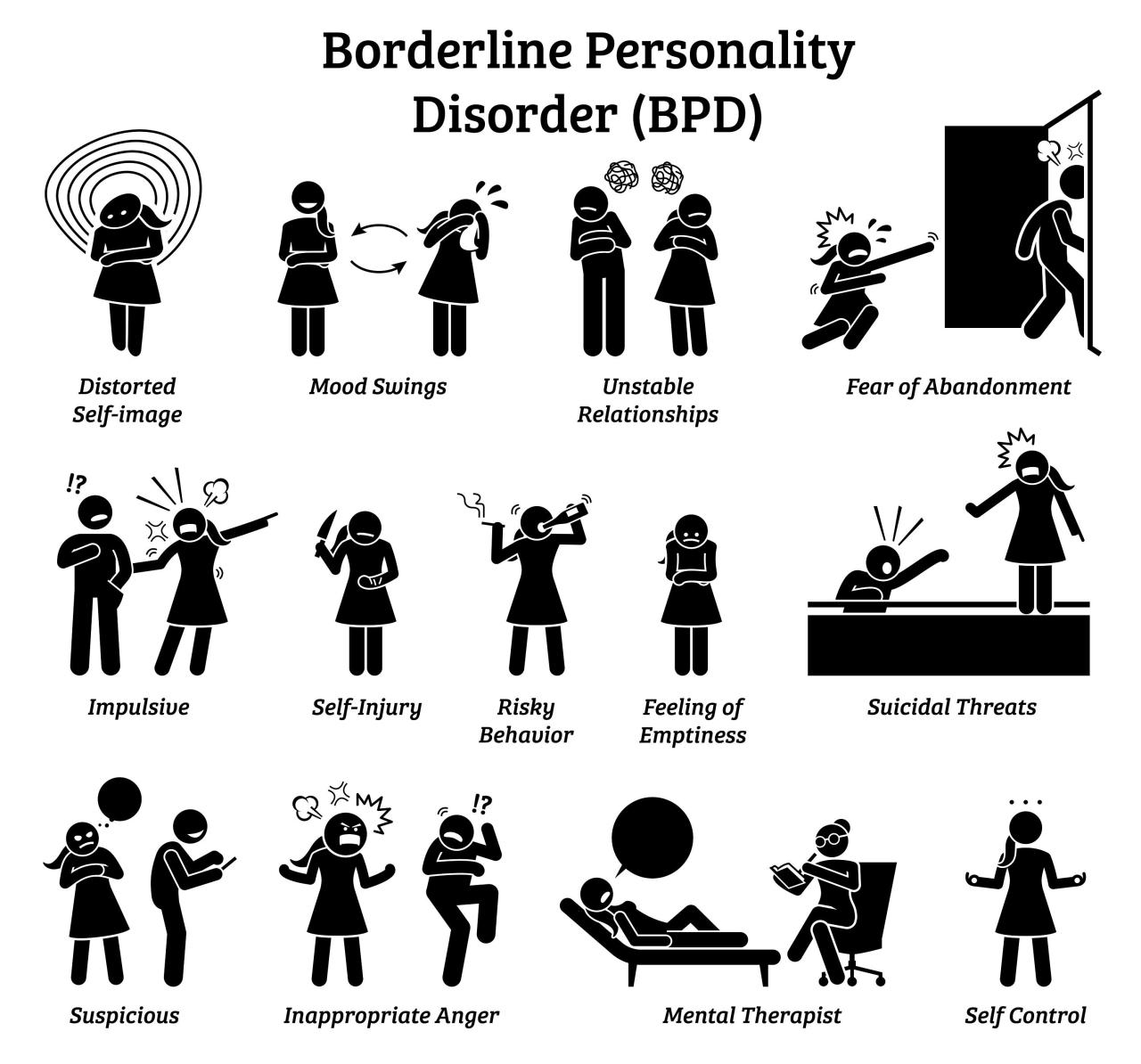Borderline personality disorder (BPD), a perplexing and enigmatic condition, captivates the attention of mental health professionals and individuals alike. Its intricate tapestry of symptoms and challenges paints a complex portrait of a disorder that profoundly impacts the lives of those who experience it.
BPD is characterized by a pattern of intense and unstable relationships, impulsivity, self-destructive behaviors, and a fluctuating sense of self-identity. Its prevalence and demographics vary across populations, but it is estimated to affect approximately 1.6% of the general population.
Overview of Borderline Personality Disorder

Borderline Personality Disorder (BPD) is a severe mental health condition characterized by intense emotions, impulsive behaviors, and difficulty maintaining stable relationships.
The key symptoms of BPD include:
- Emotional instability and mood swings
- Impulsivity and self-destructive behaviors
- Intense fear of abandonment
- Unstable relationships
- Identity disturbance
- Suicidal thoughts or behaviors
BPD is diagnosed based on the presence of five or more of these symptoms. The disorder is more common in women than men and typically begins in adolescence or early adulthood.
Causes and Risk Factors for Borderline Personality Disorder
Borderline personality disorder (BPD) is a complex mental illness that affects a person’s emotions, thoughts, and behaviors. While the exact cause of BPD is unknown, research suggests that a combination of genetic and environmental factors play a role in its development.
Genetic Factors
Studies have shown that BPD tends to run in families, suggesting a genetic component to the disorder. However, the exact genes responsible for BPD have not yet been identified. It is believed that multiple genes may interact with each other and with environmental factors to increase the risk of developing BPD.
Environmental Factors
Environmental factors, particularly during childhood, are thought to play a significant role in the development of BPD. These factors include:
- Childhood Trauma:Exposure to physical, sexual, or emotional abuse or neglect in childhood has been strongly linked to the development of BPD.
- Unstable or Invalidating Environment:Growing up in an environment where one’s emotions and experiences are not validated or understood can contribute to the development of BPD.
- Peer Relationships:Negative or traumatic experiences with peers, such as bullying or social isolation, can also increase the risk of BPD.
Social and Cultural Factors, Borderline personality disorder
Social and cultural factors can also influence the manifestation of BPD. For example, societal stigma surrounding mental illness can make it difficult for individuals with BPD to seek help, which can lead to delayed diagnosis and treatment. Additionally, cultural norms and expectations can impact the way that BPD is expressed and perceived.
Treatment and Management of Borderline Personality Disorder
Borderline personality disorder (BPD) is a complex mental health condition that requires specialized treatment approaches. Various therapeutic modalities, medications, support groups, and self-help strategies play crucial roles in managing BPD symptoms and promoting recovery.
Therapeutic Approaches
Psychotherapy is the primary treatment for BPD. Several evidence-based therapies have been developed specifically for this disorder, including:
- Dialectical Behavior Therapy (DBT):Focuses on teaching individuals skills to regulate emotions, tolerate distress, and improve interpersonal relationships.
- Mentalization-Based Therapy (MBT):Aims to enhance an individual’s ability to understand their own and others’ mental states, leading to improved emotional regulation and social functioning.
- Schema Therapy:Addresses underlying emotional and cognitive patterns that contribute to BPD symptoms, helping individuals develop healthier coping mechanisms.
Medication
Medications can be helpful in managing specific symptoms of BPD, such as mood instability, anxiety, and impulsivity. Commonly used medications include:
- Antidepressants (e.g., selective serotonin reuptake inhibitors)
- Mood stabilizers (e.g., lithium, anticonvulsants)
- Antipsychotics (e.g., atypical antipsychotics)
Support Groups and Self-Help Strategies
Support groups provide individuals with BPD a safe and supportive environment to connect with others who understand their experiences. Self-help strategies, such as mindfulness, meditation, and journaling, can also contribute to symptom management and recovery.
Concluding Remarks

The exploration of borderline personality disorder has shed light on the intricate interplay between genetic, environmental, and social factors that contribute to its development. Effective treatment approaches, such as Dialectical Behavior Therapy (DBT), Mentalization-Based Therapy (MBT), and Schema Therapy, have emerged, offering hope for recovery and improved quality of life.
While BPD presents significant challenges, it is crucial to recognize the resilience and strength of individuals navigating its complexities. With support, understanding, and evidence-based interventions, individuals with BPD can embark on a journey towards healing and personal growth.
FAQ Resource: Borderline Personality Disorder
What are the key symptoms of BPD?
BPD is characterized by a range of symptoms, including intense and unstable relationships, impulsivity, self-destructive behaviors, emotional dysregulation, and a fluctuating sense of self-identity.
What are the potential causes of BPD?
BPD is thought to be caused by a complex interplay of genetic, environmental, and social factors. Childhood trauma, abuse, and neglect are believed to play a significant role in its development.
How is BPD treated?
Effective treatment approaches for BPD include Dialectical Behavior Therapy (DBT), Mentalization-Based Therapy (MBT), and Schema Therapy. These therapies focus on developing coping mechanisms, improving emotional regulation, and fostering healthier relationships.

